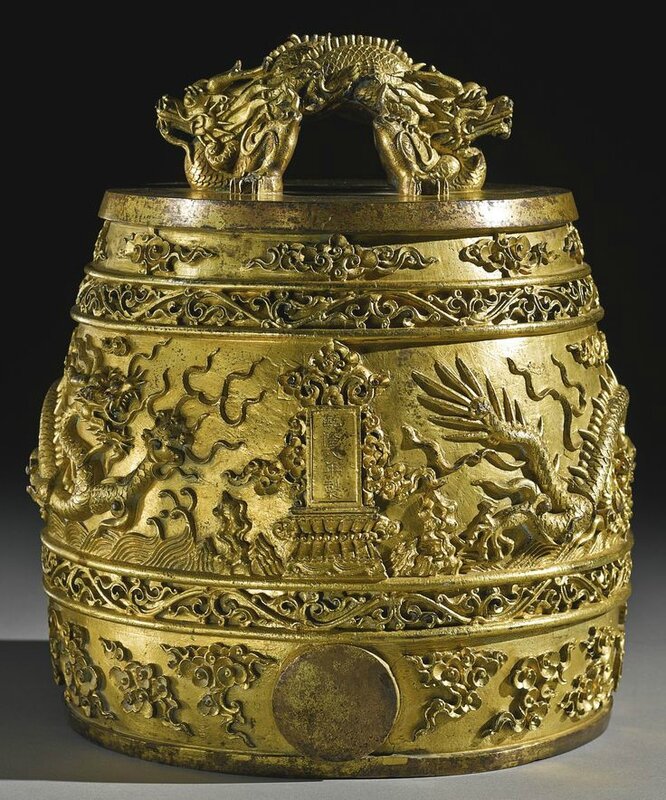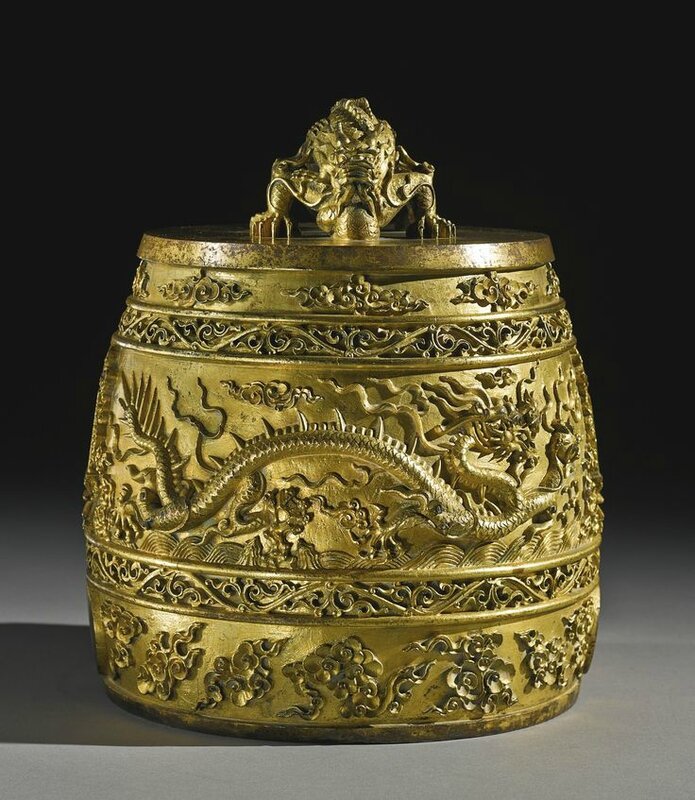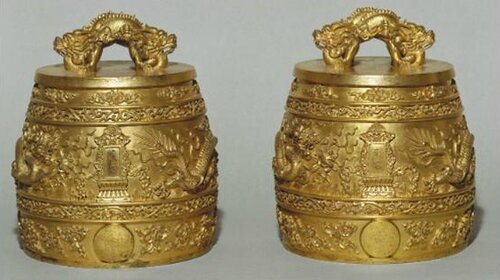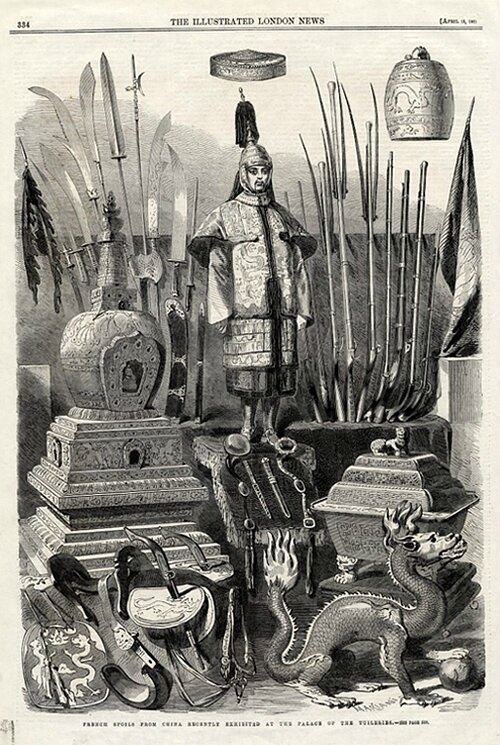A rare and important Imperial gilt-bronze ritual bell (bianzhong), Qianlong mark and period, 1743
A rare and important Imperial gilt-bronze ritual bell (bianzhong), Qianlong mark and period, dated to the eighth year, corresponding to 1743. Estimate 1,000,000 — 1,500,000 USD. Photo: Sotheby's.
finely-cast, the cylindrical form boldly surmounted by a pair of addorsed five-clawed dragons each crisply cast with a finely scaled arched back, the horned head raised with mouth agape bearing fangs, and supported on powerful extended front claws, the gently convex sides cast in sharp relief with a pair of animated dragons striding amidst roiling seas and fiery clouds, centered to either side with an upright rectangular cartouche set on a tiered lotus stand and ornamented on three sides with symmetrical cloud scrolls, one enclosing an incised reign mark Qianlong banian zhi, the opposing similar panel incised with three characters beinanlu, the low octave of the tenth note, the bell's musical pitch, all between bands of formal foliate scroll and stylized clouds, a circular striking disc centrally placed to the front and back. Height 10 3/4 in., 27.3 cm
Provenance: Yamanaka & Co., Ltd.
The American Art Galleries, New York, The Notable Yamanaka Collection of Artistic Oriental Objects and Decorative Art, 5th February 1921, lot 579.
Collection of William Randolph Hearst (1863-1951), purchased from the above auction.
Collection of Blanche Wilbur Hill (former daughter-in-law of William Randolph Hearst), purchased from the above collection, 9th January 1961.
Thence by descent in the Hearst family.
Notes: This imperial bell comes from the massive and diverse collection of one of America’s most audacious and influential figures. William Randolph Hearst (1863-1951) was born in San Francisco, California, the only child of Phoebe Apperson Hearst (1842-1919) and George Hearst (1820-1891). The elder Mr. Hearst was a self-made man who earned his wealth through his endeavors in mining and ranching and later in life turned to politics serving as a United States Senator. Mrs. Hearst was a philanthropist and strong advocate for women’s education. She also enjoyed the arts, often traveling, attending exhibitions and purchasing works of art for personal pleasure and as donations to institutions. Later in life, when William Randolph Hearst reminisced about his youth, he would credit his mother with broadening his cultural horizons and introducing him to his lifelong passion for art and collecting.
William Randolph Hearst
Energetic, intelligent, ambitious and not overly fond of formalized education, Hearst gravitated towards journalism and the publishing business and in 1887 took control of the The San Francisco Examiner, a struggling newspaper owned by his father. Under his guidance, the newspaper rebounded and Hearst went on to become the nation's largest and most prominent publisher. Despite the demands of his career, Hearst found ample time to pursue his great passion for art; the present bell being only one of many thousands of objects in his collection. It was acquired in 1921 at an auction of Far Eastern works of art collected for the sale by Sadajiro Yamanaka (1866-1936). The famous Japanese dealer opened his first shop in New York City in 1895 and by the 1930s had galleries in Boston, Chicago, London, Paris, Beijing, Shanghai, Kyoto and Osaka. Starting in 1912, Yamanaka sold regularly through the American Art Galleries; many of the sales garnered much attention, with newspapers reporting on the purchases made by many of the most notable collectors and social figures of the time. It would be only natural that Hearst would be aware of and inclined to participate in a Yamanaka sale. After the bell was purchased by Hearst, it was sent on the 3rd of May 1921, to his extraordinary residence Hearst Castle. After his death in 1951, the bell remained in storage until 9th January 1961 when it was acquired by a member of the family, Mrs. Blanche Wilbur Hill, who had been married to Hearst’s eldest son, George Randolph Hearst (1904-1972) ensuring that it remained in the family collection. In one of the multitude of obituary notices for William Randolph Hearst, it was surmised that he accounted for twenty-five percent of the world’s art market during the 1920s and 30s. Much of the incredibly diverse collection has been sold or donated over the years but much of it may still be seen today at Hearst Castle, San Simeon, California.
Two imperial bianzhong dated to the eighth year of the Qianlong reign, Château de Fontainebleau © RNN-Grand Palais/Art Resource NY.
Illustrated London News, 13 April 1861. (Bell-top right hand corner)
Sotheby's. Important Chinese Art, New York, 15 sept. 2015

/https%3A%2F%2Fprofilepics.canalblog.com%2Fprofilepics%2F1%2F0%2F100183.jpg)
/https%3A%2F%2Fstorage.canalblog.com%2F03%2F02%2F119589%2F96711876_o.jpg)
/https%3A%2F%2Fstorage.canalblog.com%2F11%2F31%2F119589%2F94773502_o.jpg)
/https%3A%2F%2Fstorage.canalblog.com%2F20%2F83%2F119589%2F94772815_o.jpg)
/https%3A%2F%2Fstorage.canalblog.com%2F26%2F72%2F119589%2F75604929_o.jpg)
/https%3A%2F%2Fstorage.canalblog.com%2F59%2F60%2F119589%2F26458628_o.jpg)












/http%3A%2F%2Fstorage.canalblog.com%2F51%2F45%2F119589%2F112100907_o.jpg)
/http%3A%2F%2Fstorage.canalblog.com%2F22%2F65%2F119589%2F112099900_o.jpg)
/http%3A%2F%2Fstorage.canalblog.com%2F21%2F71%2F119589%2F112070667_o.jpg)
/http%3A%2F%2Fstorage.canalblog.com%2F64%2F75%2F119589%2F111305738_o.jpg)